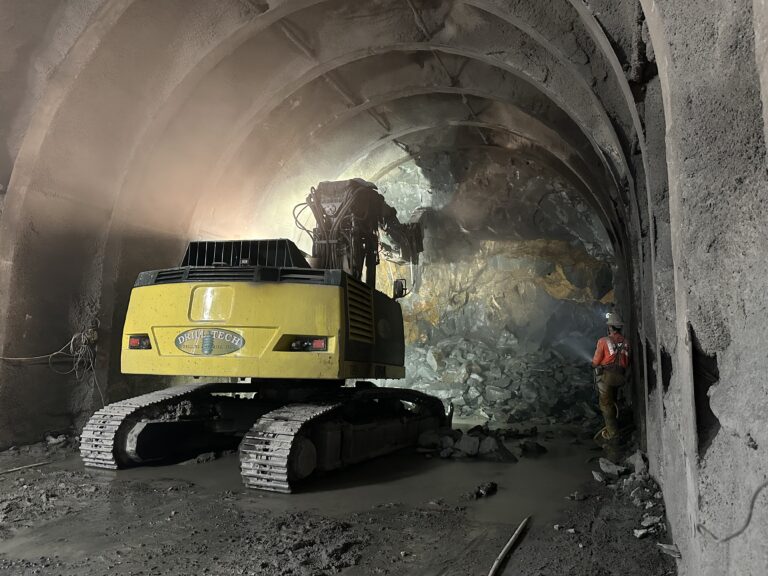Some trails at Rosendin Park will be temporarily closed for public safety
![]()

By Calvin Nuttall
Work in rebuilding earthquake-vulnerable Anderson Dam reached a milestone recently in securing Santa Clara County’s largest drinking water supply, Valley Water announced.
 Construction crews blasted through more than 800 feet of a new 1,763-foot-long spillway tunnel next to the dam, reaching that point Sept. 26, showing progress in the $1.2-billion retrofit project. The tunnel will provide a larger outlet to provide greater control of reservoir levels.
Construction crews blasted through more than 800 feet of a new 1,763-foot-long spillway tunnel next to the dam, reaching that point Sept. 26, showing progress in the $1.2-billion retrofit project. The tunnel will provide a larger outlet to provide greater control of reservoir levels.
Valley Water will begin retrofitting the embankment and spillway once the tunnel is complete. Engineers estimate that part of the project will start in late 2025 and will last about seven years.
In preparation for the next stage, Valley Water released its preliminary Environmental Impact Report Sept. 1. The 1,900-page draft document outlines the impacts of the project on the environment and the residents who live near the reservoir. The agency asked the public to provide its input by email or mail until Nov. 1. Officials expect the final report next summer.
Valley Water held a public meeting Oct. 4 to provide local residents with a summary of the report and field questions. Ryan McCarter, acting deputy operating officer, said the project is the agency’s first priority.
“In 2020 we were ordered by the federal government to keep Anderson at ‘deadpool,’ or as low as we could get it,” he said. “That’s about 3 percent capacity. That makes it unusable as a water supply asset. It being our main reservoir, that has made a little bit of a struggle with our water supply needs.”
 Built in 1950, the aging dam was found to be located in a seismically unstable zone using materials and techniques no longer considered safe in the event of a significant earthquake. As a result, the dam must be rebuilt. Anderson Reservoir holds more than 50 percent of Valley Water’s above-ground water storage capacity.
Built in 1950, the aging dam was found to be located in a seismically unstable zone using materials and techniques no longer considered safe in the event of a significant earthquake. As a result, the dam must be rebuilt. Anderson Reservoir holds more than 50 percent of Valley Water’s above-ground water storage capacity.
Because several other projects must be completed before the Anderson Dam Seismic Retrofit Project can go forward, its projected start date is 2026, with completion expected in 2032. Among the preliminary projects is the completion of the outlet tunnel to allow water to be diverted around the dam while the retrofit is underway.
“It is under construction, and we just reached about half way through the tunnel,” McCarter said. “That is set to complete just in time for construction of the dam to start.”
In addition to rebuilding the dam, the project also involves the decommissioning of the hydroelectric power plant at its base. Valley Water has no plans to upgrade it or build a new one.
“Removing the hydroelectric facility will improve (Anderson’s) cost efficiency,” he said. “That facility isn’t very cost efficient any more. It doesn’t generate enough power to make it worth running. It generates about 800 kilowatts. Usually we talk about megawatts when we’re talking about massive amounts of electricity.”
Many attending the public meeting were residents of Holiday Lakes Estates, a community that borders the now-empty reservoir. They voiced concerns about impacts on their neighborhood. Rosendin Park, located near the dam, was a matter of special interest for some. The draft EIR seemed to suggest it would be closed for the eight-year construction process.
“We basically painted out the worst case scenario, that there could possibly be full closures of the park, and it could possibly happen throughout the duration of the project,” McCarter said. “We don’t want to close your park, but we are trying to protect the public.”
McCarter explained Valley Water and Santa Clara County Parks will work together to arrange for partial and temporary closures to protect public safety, especially during the final phases of the project. To complete the dam, they will need to quarry a nearby hillside to harvest additional rock.
“This is a huge safety concern,” he said. “It is in the vicinity of some of our really intense work, such as blasting and major rock excavations that could create some very dangerous situations. There is a phenomenon called ‘flyrock’ — if you’re anywhere close you may be hit with a baseball-sized rock. You don’t want to be anywhere near this work.”
The idea to use explosives to quarry rocks was to avoid trucking it through Morgan Hill, McCarter said. The draft EIR will address issues for Holiday Estate residents as far as noise and dust monitoring and other mitigation efforts.
“It is unavoidable and significant, we won’t deny that,” he said. “We will do our best to mitigate it, but it will not prevent 100 percent of the problem.”
John Varela, Valley Water board chair and District 1 representative, emphasized the importance of respecting public safety closures.
“I’m not scolding you,” he scolded. “Those who are accessing the park by going over barriers: you are putting yourself and your family at risk. Don’t do that. This work is dangerous.”
Calvin Nuttall is a Morgan Hill-based freelance reporter and columnist.






